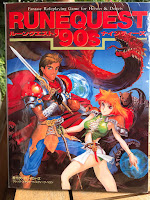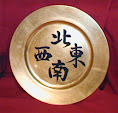This podcast about 'Gaming as Mythic Exploration' is from a session at Gen Con (2014, I do not know why it has only resurfaced now) that had assembled an incredible panel: Greg Stafford, Ken Hite, and Lillian Cohen-Moore. These are all great panellists, great game designers, but oh my God is Greg good. I would say this podcast reminds us yet again why we are such big fans of his :-)
The panellists talk about myth, legend, their place in society, in our collective psyche, and how to translate that at the gaming table and/or through game design. It's pure gold.
For those who do not like to listen to podcasts, there is also a full transcript; both podcast and transcript are available here.
About Me
28 November 2017
27 November 2017
The Language of Kralorela (Part Two)
As written in the Guide to Glorantha (p55):
“Written Kralorelan uses a logographic script devised in the God Time by a student of NiangMao and perfected by Emperor Shavaya. The characters capture the special characteristics that set apart each and every thing on the earth. The script is primarily used for seals and engraving; a less exact but easier to write derivative script devised by Emperor Mikaday is used for most purposes.”
In my campaign, I call these two styles respectively the seal style and the regular style. Both are extremely difficult and time-consuming to learn, being thus the province of aristocrats and scholars. Over time, and in particular at the time of ShangHsa and his God Learner companions, a simpler, non-logographic system was devised, which I call the demotic style, and which is only used by commoners. Its use by aristocrats or scholars entails a loss of Reputation of 1D4%.
Examples of the seal and regular styles can be seen in the Guide to Glorantha, respectively on pages 744-746 and on page 266.
The classical Kralori writing system in both its seal style and its regular style has been adapted by most other Vithelan languages (notably Imperial and Tanyen).
The debased writing system has been adopted by the Ignorants and adapted to write Stultan.
Here is how the phonemic demotic style works:
Clearly denoting God Learner influence, the shapes of the consonants and of the vowels are based on the standard runes the God Learners popularised over Glorantha at the height of their power.
The vowels have been drawn from the Elemental Runes:
Darkness - u
Water - i
Earth - e/ɛ
Air - o/ɔ
Fire/sky - a
Moon - mute/very short vowels
The consonants have been drawn from the other Runes; opposite pairs denote consonantal pairs:
Beast - k
Man - g
Fertility - t
Death - d
Harmony - p
Disorder - b
Truth - f
Illusion - v
Stasis - m
Movement - n
Movement (reversed) - ŋ
Luck - s
Fate - z
Dragonewt - ʃ
Dragon - ʒ
Pairless runes are used for unopposed consonants:
Law - l
Plant - r
Spirit - h
Chaos - q
Less-used runes play the role of diacritics:
Mastery - preceded by semi-vowel
Magic - followed by semi-vowel
Infinity - gemination
Each syllable is written separately within an imaginary square of the same size and shape as a regular character, e.g, Godunya [go - du - nja] is written
“Written Kralorelan uses a logographic script devised in the God Time by a student of NiangMao and perfected by Emperor Shavaya. The characters capture the special characteristics that set apart each and every thing on the earth. The script is primarily used for seals and engraving; a less exact but easier to write derivative script devised by Emperor Mikaday is used for most purposes.”
In my campaign, I call these two styles respectively the seal style and the regular style. Both are extremely difficult and time-consuming to learn, being thus the province of aristocrats and scholars. Over time, and in particular at the time of ShangHsa and his God Learner companions, a simpler, non-logographic system was devised, which I call the demotic style, and which is only used by commoners. Its use by aristocrats or scholars entails a loss of Reputation of 1D4%.
Examples of the seal and regular styles can be seen in the Guide to Glorantha, respectively on pages 744-746 and on page 266.
The classical Kralori writing system in both its seal style and its regular style has been adapted by most other Vithelan languages (notably Imperial and Tanyen).
The debased writing system has been adopted by the Ignorants and adapted to write Stultan.
Here is how the phonemic demotic style works:
Clearly denoting God Learner influence, the shapes of the consonants and of the vowels are based on the standard runes the God Learners popularised over Glorantha at the height of their power.
The vowels have been drawn from the Elemental Runes:
Darkness - u
Water - i
Earth - e/ɛ
Air - o/ɔ
Fire/sky - a
Moon - mute/very short vowels
The consonants have been drawn from the other Runes; opposite pairs denote consonantal pairs:
Beast - k
Man - g
Fertility - t
Death - d
Harmony - p
Disorder - b
Truth - f
Illusion - v
Stasis - m
Movement - n
Movement (reversed) - ŋ
Luck - s
Fate - z
Dragonewt - ʃ
Dragon - ʒ
Pairless runes are used for unopposed consonants:
Law - l
Plant - r
Spirit - h
Chaos - q
Less-used runes play the role of diacritics:
Mastery - preceded by semi-vowel
Magic - followed by semi-vowel
Infinity - gemination
Each syllable is written separately within an imaginary square of the same size and shape as a regular character, e.g, Godunya [go - du - nja] is written
21 November 2017
Interview with Rob Heinsoo & Jonathan Tweet
I do not mention podcasts very often on this blog, but the latest Tableplay Podcast with Rob Heinsoo and Jonathan Tweet gives a lot of insight into the creation process behind their 13th Age in Glorantha role-playing game, and so it is almost compulsory listening for all Gloranthan fans out there.
You can find it here.
You can find it here.
17 November 2017
Dealing With Demons – Part One
When you talk about RuneQuest and Old School, you inevitably think White Dwarf – at least if you are 40~50 years old and European.
One series of RQ articles we all remember fondly (even if it was “Gateway”, i.e., not set in Glorantha) was the one about demons and demonology. The first instalment in the series, titled “Dealing With Demons”, appeared in White Dwarf issue No.44 (August 1983). The good news is that it has just been made available on Dave Morris' blog. Enjoy!
One series of RQ articles we all remember fondly (even if it was “Gateway”, i.e., not set in Glorantha) was the one about demons and demonology. The first instalment in the series, titled “Dealing With Demons”, appeared in White Dwarf issue No.44 (August 1983). The good news is that it has just been made available on Dave Morris' blog. Enjoy!
13 November 2017
The Language of Kralorela (Part One)
(warning: rants about my pet Gloranthan peeve)
Even though Kralorela is supposed to be the ‘Chinese’ counterpart to the Western lands of Genertela, the Kralorelan language has never sounded Chinese in Greg’s writings.
If you look at the Kralorelan chapter of Revealed Mythologies, for instance, you can read the following:
- Place Names
Honestly, among all the above names, there aren’t many that sound even remotely Chinese; maybe Mao Tzen and Shang Hsa do. On the contrary, most are multi-syllabic names, quite unlike what one would spontaneously think of as ‘Chinese’. This is the reason I was so disappointed when I read actual Chinese words in the Guide to Glorantha, e.g., Lungren Men (p271) or Lingnao Qiao (p274). So why do I hate the latter?
1- As written above, Greg’s original Kralorelan place and people names sound nothing like ‘Chinese’.
2- Kralorela is supposed to be vaguely inspired by China, not to be its exact equivalent in Glorantha, so please no actual translations. Just when we got rid of the faux Viking names in Dragon Pass!
3- OK, let’s assume (for argument’s sake) that it is OK to equate Kralorelan with Chinese. Well, even if this assumption is true, Kralorela is still supposed to be Bronze Age China, not Qing China. Yet the Chinese words used above (e.g., 橋 qiáo for bridge) are the contemporary Mandarin words, i.e., the ones heavily influenced by Manchu pronunciation after the Manchu conquest of North China at the end of the 17th century. If Kralorela is equated with Bronze Age China, let us at least use the pre-Qing pronunciation of Chinese. For the word 橋 (bridge) this would be something along the lines of “giew”. But since, again, we are rather looking at a Bronze Age version of China, the reconstructed Old Chinese pronunciation of the word 橋 would be even better, i.e., “graw” or “grew” depending on which particular reconstruction you favour.
Lingnao Qiao (Dragon's Head Bridge) would thus become Roongnoo Graw, which still retains an imperceptible Chinese flavour but at least is slightly more similar to Greg's naming scheme.
(to be continued)
Even though Kralorela is supposed to be the ‘Chinese’ counterpart to the Western lands of Genertela, the Kralorelan language has never sounded Chinese in Greg’s writings.
If you look at the Kralorelan chapter of Revealed Mythologies, for instance, you can read the following:
- Place Names
- Abzered
- Hemkarba
- Hesezmedi
- Kerandaruth
- Daruda
- Godunya
- Heen Maroun
- Heseroon Marn
- Mao Tzen
- Metsyla
- Mikaday
- Sekever
- Shang Hsa
- Shavaya
- Tarn Gat Ha
- Thalurzni
- Vashanti
- Vayobi
- Yanoor
Honestly, among all the above names, there aren’t many that sound even remotely Chinese; maybe Mao Tzen and Shang Hsa do. On the contrary, most are multi-syllabic names, quite unlike what one would spontaneously think of as ‘Chinese’. This is the reason I was so disappointed when I read actual Chinese words in the Guide to Glorantha, e.g., Lungren Men (p271) or Lingnao Qiao (p274). So why do I hate the latter?
1- As written above, Greg’s original Kralorelan place and people names sound nothing like ‘Chinese’.
2- Kralorela is supposed to be vaguely inspired by China, not to be its exact equivalent in Glorantha, so please no actual translations. Just when we got rid of the faux Viking names in Dragon Pass!
3- OK, let’s assume (for argument’s sake) that it is OK to equate Kralorelan with Chinese. Well, even if this assumption is true, Kralorela is still supposed to be Bronze Age China, not Qing China. Yet the Chinese words used above (e.g., 橋 qiáo for bridge) are the contemporary Mandarin words, i.e., the ones heavily influenced by Manchu pronunciation after the Manchu conquest of North China at the end of the 17th century. If Kralorela is equated with Bronze Age China, let us at least use the pre-Qing pronunciation of Chinese. For the word 橋 (bridge) this would be something along the lines of “giew”. But since, again, we are rather looking at a Bronze Age version of China, the reconstructed Old Chinese pronunciation of the word 橋 would be even better, i.e., “graw” or “grew” depending on which particular reconstruction you favour.
Lingnao Qiao (Dragon's Head Bridge) would thus become Roongnoo Graw, which still retains an imperceptible Chinese flavour but at least is slightly more similar to Greg's naming scheme.
(to be continued)
Subscribe to:
Posts (Atom)











